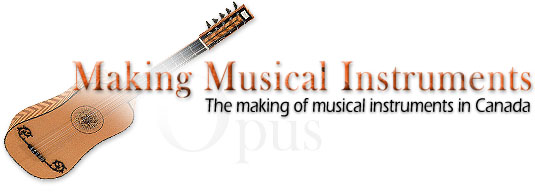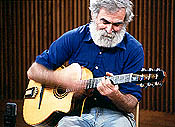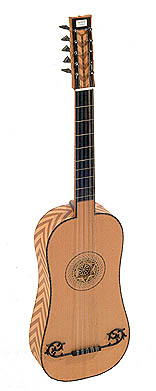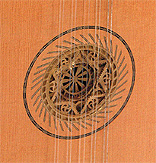
| Opus 16 - Baroque Guitar |
|
|
The baroque guitar differs from the modern guitar not only by the number of its strings, which are made of gut, but also by its smaller size, occasionally curved back, and knotted-gut frets. The rose is surrounded by ornamentation and entirely covered with fine parchment lace. Its special construction and gut strings give the baroque guitar a tone more similar to the lute than the modern guitar. A repertoire of scholarly music was written for the baroque guitar and played by reputed guitarists in the royal courts. The instrument was also used to accompany songs and traditional music. A number of celebrated luthiers, such as Antonio Stradivari (1644-1737), made baroque guitars. While these instruments were usually of simple construction, those that survive are often richly ornamented with inlays and marquetry.
Early on in the revival of stringed-instrument making in Canada, Michael Dunn built this replica of a 1641 guitar by René Voboam, which is housed in the collections of the Ashmolean Museum in Oxford. Voboam, a Parisian luthier, was renowned in the seventeenth century for his finely crafted guitars. The back of the original guitar was inlaid with a tortoiseshell chevron motif, which Dunn has reproduced in marquetry. Mounted on the peg box is a piece of ivory bearing the carved inscription "M. Dunn 1974". The Arab-style rose is made of several layers of delicately cut and gilded parchment. This finely crafted instrument is a tribute to the luthier's outstanding professionalism. Michael Dunn 
Michael Dunn has been fascinated by the guitar since the age of eleven, when he learned to play the instrument. He became a versatile guitarist, conversant with such diverse styles as jazz, folk, flamenco and bossa nova. In order to study the construction of the guitar, he undertook a two-year apprenticeship in Palma de Mallorca, Spain, under luthiers Jose Orti and Jose Ferrer. In the early 1970s, Vancouver was the centre of the revival of early music and, like several other luthiers, Dunn became interested in reproducing period instruments. In addition to sharing a workshop with luthier and lutenist Ray Nurse, who taught him to make lutes, he has built harpsichords with Edward Turner. With over twenty-five years of experience in his craft, Dunn is a leading Canadian luthier. He has built all manner of guitars, from the Renaissance vihuela to baroque guitars and acoustic jazz guitars. He has exhibited his instruments extensively in Canada and abroad. In 1980, he was invited to give demonstrations in conjunction with The Look of Music, the prestigious exhibition at the Centennial Museum (now the Vancouver Museum). While continuing to build guitars, Dunn teaches a course in stringed-instrument making at Douglas College in Vancouver. He plays with a group whose repertoire is based on the music of Django Reinhardt (who was part of France's Hot Club, a five-man group formed in Paris in 1932). Michael Dunn has built Maccaferri guitars, like those played by the legendary musician, for himself and the other members of his group.
|
 |




